I compared the benchmark score of ``2nd generation iPhone SE'' with a price of 40,000 yen with A13 Bionic & 3rd generation Neural Engine & RAM 3GB with iPhone 8 & iPhone 11

The 2nd generation iPhone SE released on April 24, 2020 is a low-priced model in the 40,000 yen range, but at the time of writing the article, it is equipped with the latest generation SoC
2nd generation iPhone SE - Apple (Japan)
https://www.apple.com/jp/iphone-se/
◆ Measured and compared with AnTuTu Benchmark
First, I tried using AnTuTu Benchmark Ver.8.1.0 as a benchmark application for smartphones.
AnTuTu Benchmark on the App Store
https://apps.apple.com/jp/app/antutu-benchmark/id803837129
From the left, iPhone 8, 2nd generation iPhone SE, iPhone 11, all of which have been updated to iOS 13.4.1. Start AnTuTu Benchmark at the same time in an environment with a temperature of 21 degrees and humidity of 45%.
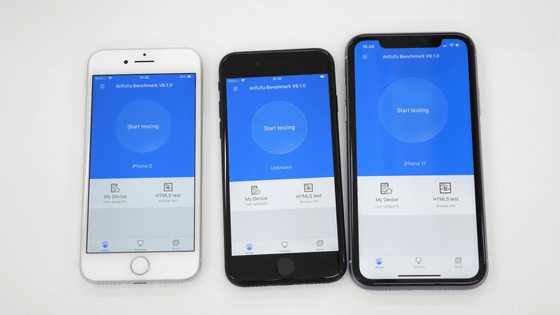
The specifications of iPhone 8, 2nd generation iPhone SE, and iPhone 11 are as follows.
| display | SoCs | RAM | Price (excluding tax) | |
| iPhone 8 | 4.7 inch Retina HD display | A11 Bionic + Neural Engine | 2GB | From 52,800 yen |
| 2nd generation iPhone SE | 4.7 inch Retina HD display | A13 Bionic + 3rd Generation Neural Engine | 3GB | From 44,800 yen |
| iPhone 11 | 6.1-inch Liquid Retina HD display | A13 Bionic + 3rd Generation Neural Engine | 4GB | From 74,800 yen |
You can see the early 3DCG rendering part in the following movie. The 2nd generation iPhone SE and iPhone 11 with the A13 Bionic chipset are processed at about the same speed, but the iPhone 8 with the A11 Bionic chipset is slightly behind the 2nd generation iPhone SE and iPhone 11, and the movie You can see that it is also slightly stuck.
Comparing movie rendering of AnTuTu Benchmark Ver8.1.0 on iPhone 8, 2nd generation iPhone SE, iPhone 11-YouTube
The results are as follows. The total score is 284,661 for the iPhone 8 (left) two generations ago, but 481,262 for the second generation iPhone SE (center) and 493,241 for the iPhone 11 (right). In terms of GPU performance, the 2nd generation iPhone SE scored nearly four times as much as the iPhone 8. The iPhone 8 and the 2nd generation iPhone SE look almost the same, but the contents seem to be very different. On the other hand, there is almost no difference in performance between the 2nd generation iPhone SE and iPhone 11.
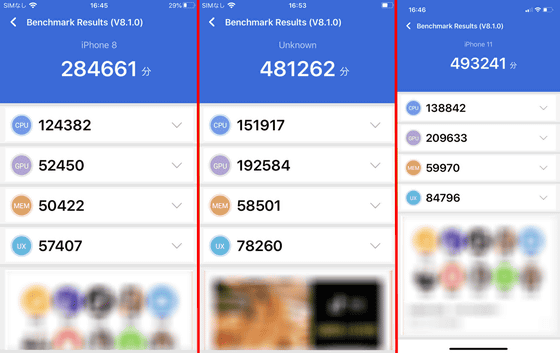
The results of running AnTuTu Benchmark on
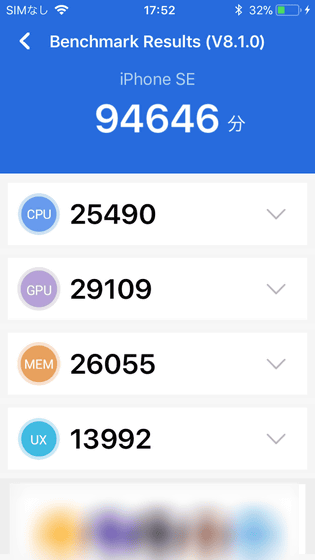
I measured the score with Geekbench 5
In addition, Geekbench 5 also benchmarked iPhone 8, 2nd generation iPhone SE, and iPhone 11. . The version is the latest Ver.5.1.1 at the time of article creation.

'Geekbench 5' on the App Store
https://apps.apple.com/jp/app/geekbench-5/id1435082259
In addition, in Geekbench 5, the second generation iPhone SE was written as 'iPhone 12, 8' for some reason. The CPU clock frequency of the A13 Bionic chipset is 2.65 GHz. Apple has not announced the RAM size of the 2nd generation iPhone SE, but the RAM is 2.88GB, which seems to be 3GB as expected before the release .

Geekbench can benchmark with two CPUs and Computing (calculation), and can be evaluated with two CPUs, single core and multicore. It is like this with iPhone 8 with A11 Bionic chipset.

And with the 2nd generation iPhone SE equipped with the A13 Bionic chipset, it looks like this. You can see that both single-core and multi-core clearly demonstrate higher performance than iPhone 8.
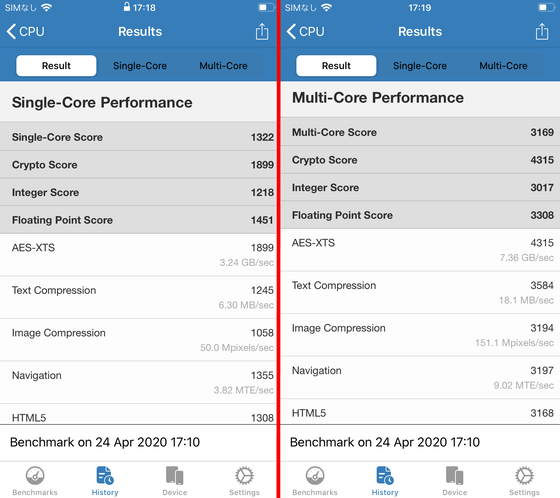
The results of iPhone 11 are below. Single-core performance is slightly higher than the 2nd generation iPhone SE, but multi-core performance is better for iPhone 11. In particular, the Crypto Score, which is the score for encryption algorithm processing performance, is significantly higher for the iPhone 11 than the 2nd generation iPhone SE for multi-core.
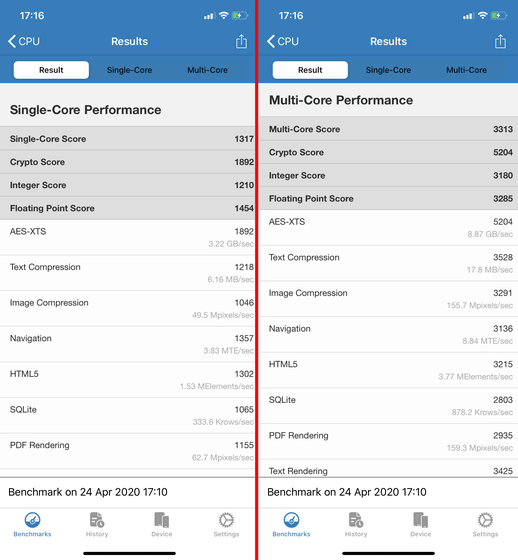
Also, the results of computing are compared below. The higher the 'Metal Score' written at the top, the higher the overall performance. The 2nd generation iPhone SE has almost double the Metal Score of the iPhone 8, which has the SoC of the previous two generations, and is no different from the iPhone 11.
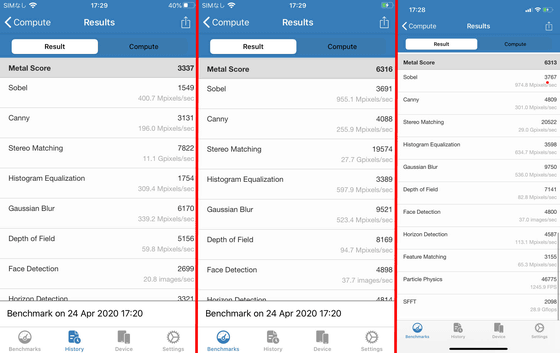
The score results of AnTuTu Benchmark and Geekbench 5 are just reference values, but it clearly shows that there is a large performance difference between the 2nd generation iPhone SE and the iPhone 8, which looks almost the same. The 2nd generation iPhone SE has almost the same processing performance as the iPhone 11, but the price is kept down, so it can be said that the cost performance is quite high. Especially for those who think 'I want to switch from iPhone 8 soon...', we can fully recommend switching to the second generation iPhone SE because 'the usability is almost the same and the performance is almost the same as the iPhone 11'. .
Also, unlike the iPhone 8, the 2nd generation iPhone SE is equipped with a 3rd generation Neural Engine, which has significantly improved image processing capabilities, and portrait mode can be used with both the rear and front cameras. Although the second-generation iPhone SE looks like the successor to the iPhone 8, it can be said that the contents have evolved greatly. However, unlike iPhone 11, night mode and 120fps slow motion movie shooting are not possible, so be careful.
Related Posts:







